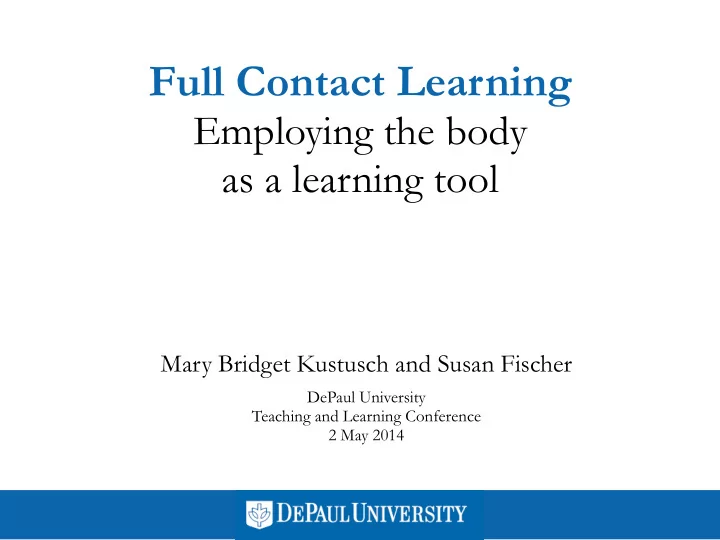

Full Contact Learning Employing the body as a learning tool Mary Bridget Kustusch and Susan Fischer DePaul University Teaching and Learning Conference 2 May 2014
Embodied Cognition “In an embodied cognition perspective, all abstractions are understood in terms of basic sensory-motor experiences such as object permanence and movement” (Scherr et al, 2012a) DePaul T&L - 2 May 2014 - 2
Our thought is grounded in our sensory experience • Time metaphors • Representational gestures • Perspective-taking DePaul T&L - 2 May 2014 - 3
������������� ���������������� ������������������ ����������������� ���������������� ���������� ����� ��������� ���������������� �������� ��������� ��������� ���� ���� ���������� ��������������� ���������������� �� ����������� ���� ��� ������������� ������ ��������������� Our thought is grounded in our sensory experience • Time metaphors • Representational gestures (Becvar et al, 2008) DePaul T&L - 2 May 2014 - 3
We use our bodies to think “The common thread across these accounts is that gestures are not simply an external manifestation of what is on the gesturer's mind. Instead, the act of gesturing influences the representations and processes that take place in the gesturer's mind.” (Alibali, 2005) DePaul T&L - 2 May 2014 - 4
Using our bodies to learn “Theories of embodied cognition and cognitive linguistics suggest to us that among all possible objects, a particularly cognitively compelling sense of permanence might be attached to the self, and that use of the human body might have special significance for learning.” (Scherr et al, 2012b) DePaul T&L - 2 May 2014 - 5
We should allow students to use their bodies to learn • Kinesthetic activity • Embodied representation • Physical mnemonics • Embodied interaction • Embodied Learning Activity (ELA) Any activity where the body is used as a tool for learning! DePaul T&L - 2 May 2014 - 6
Reasons to use ELAs Allow students to... • ... make sense of counter-intuitive scenarios • ... ground abstract ideas in the concrete world • ... create their own ideas • ... develop shared language and community DePaul T&L - 2 May 2014 - 7
Motivating the activity linear momentum = (mass)*(velocity) p = mv For rotational motion: espn.go.com/nhl/tesm/photos angular momentum = (moment of inertia)*(angular velocity) L = I ω What is the moment of inertia of an object? ++ Rulers + Binder clips! DePaul T&L - 2 May 2014 - 8
What did we learn? It is harder to “flip” the ruler the further the binder clip is from the pivot point. “Harder” means a larger moment of inertia. The moment of inertia of an object depends ++ on how the mass of the object is distributed If you change the location of the pivot point, you affect the difficulty in “flipping” the ruler. The moment of inertia of an object depends on ++ where the pivot point (or axis of rotation) is. DePaul T&L - 2 May 2014 - 9
What did we learn? The two identical solid cylinders shown below are spinning about different axes. Which configuration has the larger Moment of Inertia? A B DePaul T&L - 2 May 2014 - 10
How does this apply? How does this apply to angular momentum and ice skaters? Compare what is happening when the skater first starts spinning, and when the skater is about to finish the spin. What changes? What can we learn about angular momentum? (angular momentum) = (moment of inertia) * (angular velocity) DePaul T&L - 2 May 2014 - 11
Activity 2: DePaul T&L - 2 May 2014 - 12
Some ELAs use the body... DePaul T&L - 2 May 2014 - 13
... as a sensor Feeling 1-dimensional motion Using a bicycle wheel to feel changes in angular momentum DePaul T&L - 2 May 2014 - 14
... to change perspective Creating non-linear charge density “building” DNA ete particles. Energy Theater DePaul T&L - 2 May 2014 - 15
... to explore relationships Sky Time: relationship between Flow of time and astronomical motion charges in a uniform current density Energy transfers & transformations for a hand pushing a box across a floor at constant speed. The life cycle of a star DePaul T&L - 2 May 2014 - 16
... to represent abstract ideas Transverse Waves Time evolution of a complex 2-state system Acting out the meter of a poem DePaul T&L - 2 May 2014 - 17
Creating an ELA I want an ELA that explores... • ... interactions or transformations • ... complex or dynamic systems • ... changes in orientation or perspective • ... quantities with properties that vary in space • ... something too abstract for an ELA DePaul T&L - 2 May 2014 - 18
Questions to consider: • What are your goals for the activity? • What do you want your students to learn? • How much do you want the students to direct the exploration? • How much time will it take? • Can you get all students involved? • How can you make it safe to participate? DePaul T&L - 2 May 2014 - 19
Recommend
More recommend